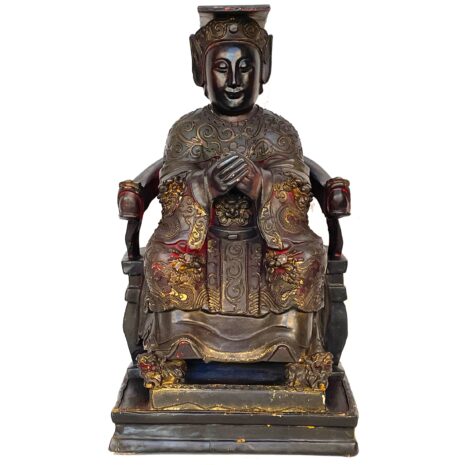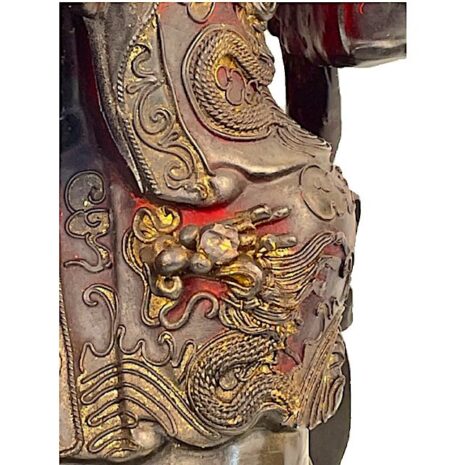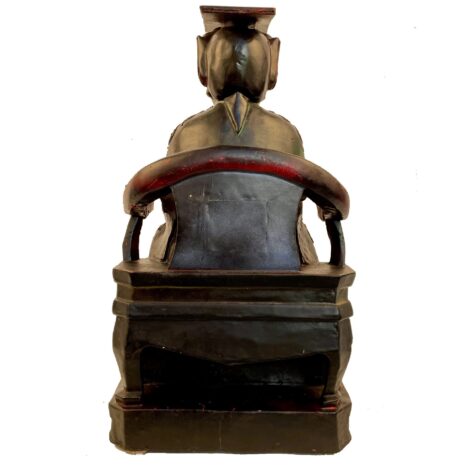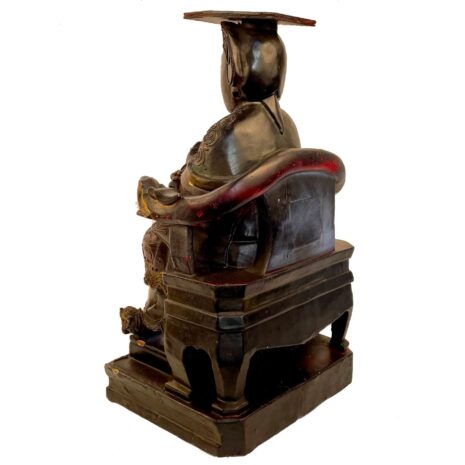Antique Mazu Empress of Heaven in Horseshoe Chair, China (6003)
Original price was: $1,050.00.$650.00Current price is: $650.00.
H: 15.375” W: 8.625” D: 7.5” | CONTACT US AT 213-568-3030 or email [email protected] for SHIPPING.
Mazu, protector of sea, is portrayed as the imperially sanctioned “Empress of Heaven” on an elaborate, horseshoe shaped dragon throne, holding a hu tablet, with elegant dragon robes, official’s girdle, Empress headdress and small feet on gilt fu lion foot rest.
Description
Mazu represents different ideologies among two distinct Chinese economic groups: the masses of devotees who adore her in oral traditions as the humble provincial deity “Goddess of the Sea” versus the imperial followers who revere her in written tradition as the sanctioned “Empress of Heaven.” Two centuries after her death she was imperially sanctified, transforming her from a simple and kind peasant cult figure to one of the highest-ranking female Taoist-deities. In the Yuan Dynasty, she became the Brilliantly Outstanding Heavenly Queen and during the early Qing was designated “Mother of Heaven” and “Empress of Heaven.” As Empress of Heaven here she is regally dressed with a flat ceremonial Empress hat and her characteristically small feet rest on foot rest held up by pair of gilt fu-lions, Buddhist mythical animals displaying her deified nature and immense power. One imperial myth states that when Mazu died, a rainbow appeared indicating the presence of a dragon which is reflected in her robes decorated with dragons, an official girdle surrounding a dragon head and arms of her horseshoe chair with open-mouthed dragons holding pearls. Her hands crossed in front of her chest symbolically hold a ceremonial hu-tablet. This antique-Chinese-wood-carving may be from southern mainland China or Taiwan where she is often represented with a black face that symbolizes her impartiality and reflects her relationship to the water and the North, both associated with black. The remaining polychrome reflects the original red, green, and blue laced with raised gilt highlights, now darkened by years of incense and candle smoke. The sealed bung on the back indicates it was consecrated and its size indicates it may have been on a home altar. She is a syncretic deity reflecting the blend of many religions and is a tutelary deity as Protectress of the Seas. Lee Irvin defines her as one of the Great Chinese Goddesses who are imperially sanctioned and epitomize the feminine role of compassionate protectors who grant health, long life and safety in distress to all devotees regardless of class. Meant to be seen from all sides it is decorated on front and back and is in excellent condition although the front of her hat was broken and reattached and it has expected minor scratches and losses.
Sources
Lee Irwin, “Divinity and Salvation: The Great Goddesses of China,” in Asian Folklore Studies, Indiana University, Vol. 49, 1990, pp 53-68.
Claudia Monique, “Matsu/Mazu Goddess of Sea,” May 20, 2014.
Additional information
| Period | Antique, Qing Dynasty |
|---|---|
| Date | 19th Century |
| Materials and Technique | Wood |
| Dimensions (inches) | Ht: 15.375” W: 8.625” D:7.5” |
| Dimensions (metric) | Ht: 39.05cm W: 21.91cm D: 19.05cm |
| Weight | 7lbs 5oz |
| Condition | Excellent, fine patina demonstrating age and use |
| Item Number | 6003A-BCK |
| Shipping Box Size | Oversized. Call 213-568-3030 or email [email protected] for shipping. |










